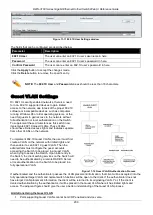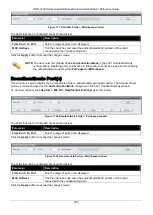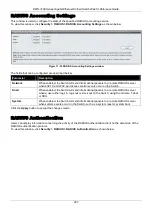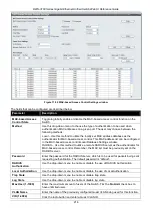
DWS-3160 Series Gigabit Ethernet Unified Switch Web UI Reference Guide
210
The user may also select the desired time interval to update the statistics, between
1s
and
60s
, where “s” stands
for seconds. The default value is one second.
The fields that can be configured are described below:
Parameter
Description
ServerIndex
The identification number assigned to each RADIUS Accounting server that the client
shares a secret with.
InvalidServerAddr
The number of RADIUS Accounting-Response packets received from unknown
addresses.
Identifier
The NAS-Identifier of the RADIUS accounting client.
ServerAddr
The IP address of the RADIUS authentication server referred to in this table entry.
ServerPortNumber
The UDP port the client is using to send requests to this server.
RoundTripTime
The time interval between the most recent Accounting-Response and the Accounting-
Request that matched it from this RADIUS accounting server.
Requests
The number of RADIUS Accounting-Request packets sent. This does not include
retransmissions.
Retransmissions
The number of RADIUS Accounting-Request packets retransmitted to this RADIUS
accounting server. Retransmissions include retries where the Identifier and Acct-
Delay have been updated, as well as those in which they remain the same.
Responses
The number of RADIUS packets received on the accounting port from this server.
MalformedResponses
The number of malformed RADIUS Accounting-Response packets received from this
server. Malformed packets include packets with an invalid length. Bad authenticators
and unknown types are not included as malformed accounting responses.
BadAuthenticators
The number of RADIUS Accounting-Response packets, which contained invalid
authenticators, received from this server.
PendingRequests
The number of RADIUS Accounting-Request packets sent to this server that have not
yet timed out or received a response. This variable is incremented when an
Accounting-Request is sent and decremented due to receipt of an Accounting-
Response, a timeout or a retransmission.
Timeouts
The number of accounting timeouts to this server. After a timeout the client may retry
to the same server, send to a different server, or give up. A retry to the same server is
counted as a retransmit as well as a timeout. A send to a different server is counted
as an Accounting-Request as well as a timeout.
UnknownTypes
The number of RADIUS packets of unknown type which were received from this
server on the accounting port.
PacketsDropped
The number of RADIUS packets, which were received from this server on the
accounting port and dropped for some other reason.
Click the
Clear
button to clear the current statistics shown.
IP-MAC-Port Binding (IMPB)
The IP network layer uses a four-byte address. The Ethernet link layer uses a six-byte MAC address. Binding these
two address types together allows the transmission of data between the layers. The primary purpose of IP-MAC-
port binding is to restrict the access to a switch to a number of authorized users. Authorized clients can access a
switch’s port by either checking the pair of IP-MAC addresses with the pre-configured database or if DHCP
snooping has been enabled in which case the switch will automatically learn the IP/MAC pairs by snooping DHCP
packets and saving them to the IMPB white list. If an unauthorized user tries to access an IP-MAC binding enabled
port, the system will block the access by dropping its packet. For the DWS-3160 series of switches, active and
inactive entries use the same database. The maximum number of entries is 510. The creation of authorized users
can be manually configured by CLI or Web. The function is port-based, meaning a user can enable or disable the
function on the individual port.
















































